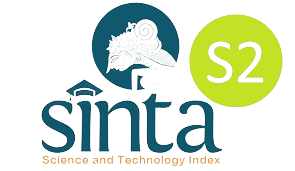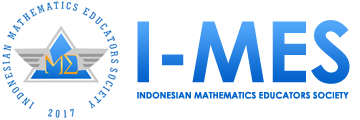Wura Bongi Monca dance as a promising context for fostering problem-solving skills in learning set theory
DOI:
https://doi.org/10.29408/jel.v11i4.30579Keywords:
ethnographic approach, ethnomathematics, problem-solving ability, set theory, traditional Bima dance Wura Bongi MoncaAbstract
The Wura Bongi Monca dance embodies the philosophical values of Bima culture, which can be contextualized to facilitate students' understanding of abstract mathematical concepts, such as set theory. Although most ethnomathematics research has focused on concrete elements such as geometric shapes and numerical patterns in cultural practices, little attention has been given to how cultural values can support the teaching of abstract topics. Yet, local traditions hold significant potential to provide meaningful contexts for such learning. This study addresses that gap by investigating the traditional Bima dance Wura Bongi Monca as a contextual learning resource to introduce set theory and enhance students' problem-solving skills. Problem-solving is a key mathematical competency, indicating conceptual understanding, critical thinking, and the ability to apply knowledge in new situations. It also serves as a benchmark for evaluating the impact of culturally contextualized instruction. Using an ethnography approach including literature review, field observations, and interviews with cultural experts, the study interprets the symbolic meanings of Gerak Wura, the dance's core movements, and connects them to set theory concepts. The findings demonstrate that dance can foster conceptual understanding and cultural awareness, support culturally responsive mathematics education while preserving local heritage and providing insights for innovative instructional design.
References
Abdullah, A. H., Zakaria, M. I., Mokhtar, M., Khairuddin, N. K., Rasol, N. I. A. M., Hanafi, N. H., Suhaimee, N. R. A., Syahri, I., Antoni, A., Susanti, R., & Yuliarni. (2025). The impact of ethnomathematics activities using Zapin and Kuda dances on students’ academic achievement and appreciation of isometric transformations. Mathematics Education Journal, 19(2), 299–322. https://doi.org/10.22342/mej.v19i2.pp299-322
Akar, N., & Işıksal-Bostan, M. (2024). The didactic transposition of quadrilaterals: The case of 5th grade in Turkey. International Journal of Mathematical Education in Science and Technology, 55(3), 628–649. https://doi.org/10.1080/0020739X.2021.2022228
Alghiffari, E. K., Prahmana, R. C. I., & Evans, B. (2024). The impact of Ethno-Realistic Mathematics Education-based e-module in strengthening students’ problem-solving abilities. Jurnal Elemen, 10(3), 546–566. https://doi.org/10.29408/jel.v10i3.26611
Apsari, R. A., & Abrahamson, D. (2024). Dancing geometry: Imagining auxiliary lines by reflecting on physical movement. International Journal of Mathematical Education in Science and Technology, 1–28. https://doi.org/10.1080/0020739X.2024.2427099
Chenhall, R., Senior, K., & Belton, S. (2011). Negotiating human research ethics: Case notes from anthropologists in the field. Anthropology Today, 27(5), 13–17. https://doi.org/10.1111/j.1467-8322.2011.00827.x
Creswell, J. W., & Poth, C. N. (2016). Qualitative inquiry and research design: Choosing among five approaches. Sage publications.
D'Ambrosio, U. (1989). On ethnomathematics. Philosophia Mathematica, 2(1), 3–14. https://doi.org/10.1093/philmat/s2-4.1.3
Denzin, N. K. (2012). Triangulation 2.0. Journal of Mixed Methods Research, 6(2), 80–88. https://doi.org/10.1177/1558689812437186
Ergene, Ö., Çaylan Ergene, B., & Yazıcı, E. (2020). Ethnomathematics activities: Reflections from the design and implementation process. Turkish Journal of Computer and Mathematics Education, 11(2), 402–437. https://doi.org/10.16949/turkbilmat.688780
Ernest, P., Skovsmose, O., Bendegem, J. P., Bicudo, M., Miarka, R., Kvasz, L., & Moeller, R. (2016). The Philosophy of Mathematics Education. Springer Nature. https://doi.org/10.1007/978-3-319-40569-8_1
Fadilah, N., Dewi, I., & Ahyaningsih, F. (2024). Relationship between mathematics education philosophy and traditional Malay culture in Serampang 12. Inovasi Kurikulum, 21(4), 2331–2346. https://doi.org/10.17509/jik.v21i4.76071.
Fischbein, E., & Baltsan, M. (1998). The mathematical concept of set and the 'collection' model. Educational Studies in Mathematics, 37(1), 1–22. https://doi.org/10.1023/A:1003421206945
Hadi, H., Juandi, D., & Rusdiana, D. (2023). Problem solving ability analysis: Systematic literature review. Journal of Mathematics and Mathematics Education, 13(1), 33–43. https://doi.org/10.20961/jmme.v13i1.73819
Hasanah, S. I., Tafrilyanto, C. F., & Aini, Y. (2019). Mathematical reasoning: The characteristics of students’ mathematical abilities in problem solving. Journal of Physics: Conference Series, 1188(1), 012057. https://doi.org/10.1088/1742-6596/1188/1/012057
Hendriyanto, A., Suryadi, D., Juandi, D., Dahlan, J. A., Hidayat, R., Wardat, Y., Sahara, S., & Muhaimin, L. H. (2024). The didactic phenomenon: Deciphering students’ learning obstacles in set theory. Journal on Mathematics Education, 15(2), 517–544. https://doi.org/10.22342/jme.v15i2.pp517-544
Khasanah, B. A., Prahmana, R. C. I., Adiputra, S., & Arnal-Palacián, M. (2025). The beauty of mathematics in Indonesian culture: An impactful and meaningful context in number patterns learning. JRAMathEdu (Journal of Research and Advances in Mathematics Education, 10(2), 68–80. https://doi.org/10.23917/jramathedu.v10i2.10441
Ladson-Billings, G. (1995). Toward a theory of culturally relevant pedagogy. American Educational Research Journal, 32(3), 465–491. https://doi.org/10.3102/00028312032003465
Lave, J., & Wenger, E. (1991). Situated learning: Legitimate peripheral participation. Cambridge University Press.
Lipka, J., Sharp, N., Brenner, B., Yanez, E., & Sharp, F. (2005). The relevance of culturally based curriculum and instruction: The case of Nancy sharp. Journal of American Indian Education, 44(3), 31–54. http://www.jstor.org/stable/24398496
Maddy, P. (2007). Second philosophy: A naturalistic method. OUP Oxford.
Mataheru, W., Laurens, T., & Taihuttu, S. M. (2023). The development of geometry learning using traditional dance context assisted by GeoGebra. Jurnal Elemen, 9(1), 65–83. https://doi.org/10.29408/jel.v9i1.6628
Novikasari, I., Muttaqin, A., & Elebiary, N. (2024). Teaching math and preserving culture: The intersection of values in Indonesian pedagogy. In Y. Dede, G. Marschall, & P. Clarkson (Eds.), Values and Valuing in Mathematics Education. Springer. https://doi.org/10.1007/978-981-99-9454-0_17
OECD. (2023). PISA 2022 results (Volume I). The state of learning and equity in education. https://doi.org/10.1787/53f23881-en
Patton, M. Q. (2002). Qualitative research and evaluation methods.
Prahmana, R. C. I. (2022). Ethno-realistic mathematics education: The promising learning approach in the city of culture. SN Social Sciences, 2(12), 1–19. https://doi.org/10.1007/s43545-022-00571-w
Prahmana, R. C. I., & Istiandaru, A. (2021). Learning sets theory using shadow puppet: A study of Javanese ethnomathematics. Mathematics, 9(22), 2938. https://doi.org/10.3390/math9222938
Prahmana, R. C. I., Risdiyanti, I., Peni, N. R. N., Ristiana, N., & Ramadhani, R. (2025). Javanese folklore with moral values: An impactful context in learning relations and functions. Journal on Mathematics Education, 16(1), 197–224. https://doi.org/10.22342/jme.v16i1.pp197-224
Pujiastuti, N. I., Prahmana, R. C. I., & Evans, B. (2025). Innovative Ethno-Realistic Mathematics-based modules: Promoting Pancasila values in Indonesian mathematics education. Jurnal Pendidikan Matematika, 19(1), 1–22. https://doi.org/10.22342/jpm.v19i1.pp1-22
Radiusman, R., Wardani, K. S. K., Apsari, R. A., Nurmawanti, I., & Gunawan, G. (2021). Ethnomathematics in Balinese traditional dance: A study of angles in hand gestures. Journal of Physics: Conference Series, 1779(1), 012074. https://doi.org/10.1088/1742-6596/1779/1/012074
Rosa, M., & Orey, D. C. (2011). Ethnomathematics: The cultural aspects of mathematics. Revista Latinoamericana de Etnomatemática Perspectivas Socioculturales de La Educación Matemática, 4(2), 32–54. https://www.revista.etnomatematica.org/index.php/RevLatEm/article/view/32
Spradley, J. P. (1980). Participant observation. Holt, Rinehart, and Winston.
Sulistyawati, E., Nirmala, B. I., & Hamidah, D. (2025). Ethnomathematical exploration of the Remo dance as a source for mathematics learning. Jurnal Elemen, 11(1), 34–49. https://doi.org/10.29408/jel.v11i1.26997
Susanti, E., & Ulum, M. M. (2021, 2021). The model of etnomathematics for high schools based on the dancers position movement of beskalan putri malang dance Proceedings of the International Conference on Engineering, Technology and Social Science (ICONETOS 2020, http://dx.doi.org/10.2991/assehr.k.210421.024
Valeeva, R., Biktagirova, G., Lesev, V., Mikhailenko, O., Skudareva, G., & Valentovinis, A. (2023). Exploring the impact of modeling in science education: A systematic review. Eurasia Journal of Mathematics, Science and Technology Education, 19(6), 2284. https://doi.org/10.29333/ejmste/13268
Wiri, P. E. W., Dominikus, W. S., & Udil, P. A. (2023). Ethnomathematics exploration in the Ped’Oa traditional dance of the Sabu community in the Raijua district. Jurnal Pendidikan Matematika (JUPITEK, 6(1), 27–35. https://doi.org/10.30598/jupitekvol6iss1pp27-35
Yanti, S. (2025). The role of ethnomathematics in enhancing contextual mathematics understanding among students. International Journal of Humanity Advance, Business & Sciences (IJHABS, 2(4), 321–330. https://doi.org/10.59971/ijhabs.v2i4.402
Yılmaz, N. (2020). Making the association between culture and mathematics education. Education Research Highlights in Mathematics, Science and Technology, 81–104. https://www.isres.org/books/chapters/Erhmst2020-81-104_29-12-2020.pdf
Downloads
Published
How to Cite
Issue
Section
License
Copyright (c) 2025 Khairullah, Rully Charitas Indra Prahmana, Nur Robiah Nofikusumawati Peni

This work is licensed under a Creative Commons Attribution-ShareAlike 4.0 International License.
Authors who publish with the Jurnal Elemen agree to the following terms:
- Authors retain copyright and grant the journal right of first publication with the work simultaneously licensed under Creative Commons Attribution-ShareAlike 4.0 International License (CC BY-SA 4.0).
- Authors are able to enter into separate, additional contractual arrangements for the distribution of the journal's published version of the work (e.g., post it to an institutional repository or publish it in a book), with an acknowledgment of its initial publication in this journal.
- Authors are permitted and encouraged to post their work online (e.g., in institutional repositories or on their website) prior to and during the submission process, as it can lead to productive exchanges, as well as earlier and greater citation of published work.
Jurnal Elemen is licensed under a Creative Commons Attribution-ShareAlike 4.0 International License





